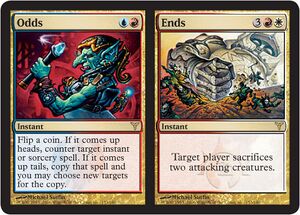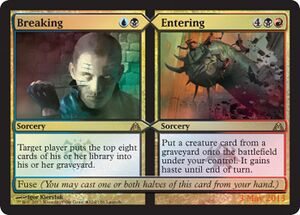Split card

Split cards are Magic cards with two card faces on the front side. A split card is literally "split" into two separate cards each with its own card name, art, mana cost, text, etc. Split cards can only be instants and sorceries, not permanents.[1]
Description
In any zone except the stack, a split card has the combination of both characteristics; while it's on the stack, it only has the characteristics of the half being played. This provides many interesting interactions with cards that create effects based on converted mana cost. For example, if Dark Confidant reveals a split card, you would lose life equal to the total converted mana cost of both sides.
Split cards are considered to be deciduous.[2]
History

Split cards were introduced in the Invasion block, where each half was from a different color.[3] In Dissension each half was a multicolored card from a different guild.[4][5] Planar Chaos had split cards were introduced where both halves were the same color (all split cards in PC are red).
After the introduction of split cards, Unhinged featured Who/What/When/Where/Why which resembled a split card with five different effects.
Dragon's Maze introduced split cards with Fuse, an ability that lets you play both halves as one spell.[6] Amonkhet added split cards with Aftermath, an ability that lets you play the 'bottom' part from the graveyard.[7][8] Split cards with aftermath have a new frame treatment — the half you can cast from your hand is oriented the same as other cards you'd cast from your hand, while the half you can cast from your graveyard is a traditional split card half. This frame treatment is for your convenience and has no rules significance.
Split cards returned again in Guilds of Ravnica. Each one focuses on a single guild, with a smallish hybrid mana effect as one half and a bigger, multicolor mana effect as the other.[9][10][11] The art of the rares focuses on the two major characters (legendary creatures or planeswalkers) in that guild, one personality per side.
Naming convention
Regular split cards are named with a ”__________ and __________“ convention while Aftermath cards use a ”__________ to __________“ convention.[12][13] In Guilds of Ravnica, the card halves have alliterative names, starting with the same three letters.
Rules

From the glossary of the Comprehensive Rules (June 7, 2024—Modern Horizons 3)
- Split Cards
- Cards with two card faces on a single card. See rule 709, “Split Cards.”
From the Comprehensive Rules (June 7, 2024—Modern Horizons 3)
- 709. Split Cards
- 709.1. Split cards have two card faces on a single card. The back of a split card is the normal Magic card back.
- 709.2. Although split cards have two castable halves, each split card is only one card. For example, a player who has drawn or discarded a split card has drawn or discarded one card, not two.
- 709.3. A player chooses which half of a split card they are casting before putting it onto the stack.
- 709.3a Only the chosen half is evaluated to see if it can be cast. Only that half is considered to be put onto the stack.
- 709.3b While on the stack, only the characteristics of the half being cast exist. The other half’s characteristics are treated as though they didn’t exist.
- 709.3c An effect may create a copy of a split card and allow a player to cast the copy. That copy retains the characteristics of the two halves separated into the same two halves as the original card. (See rule 707.12.)
- 709.4. In every zone except the stack, the characteristics of a split card are those of its two halves combined. This is a change from previous rules.
- 709.4a Each split card has two names. If an effect instructs a player to choose a card name and the player wants to choose a split card’s name, the player must choose one of those names and not both. An object has the chosen name if one of its names is the chosen name.
- 709.4b The mana cost of a split card is the combined mana costs of its two halves. A split card’s colors and mana value are determined from its combined mana cost. An effect that refers specifically to the symbols in a split card’s mana cost sees the separate symbols rather than the whole mana cost.
Example: Assault//Battery’s mana cost is {3}{R}{G}. It’s a red and green card with a mana value of 5. If you cast Assault, the resulting spell is a red spell with a mana value of 1.
Example: Fire//Ice’s mana cost is {2}{U}{R}. It has the same mana cost as Steam Augury, but an effect such as that of Jegantha, the Wellspring sees that it contains the mana symbol {1} twice.
- 709.4c A split card has each card type specified on either of its halves and each ability in the text box of each half.
- 709.4d The characteristics of a fused split spell on the stack are also those of its two halves combined (see rule 702.102, “Fuse”).
Rulings
- With Amonkhet, the converted mana cost (CMC) of split cards were simplified.[14] The CMC of a split card is always the combination of both halves except on the stack. On the stack, only the half which is actually cast is considered for color and CMC. Formerly, a split card would have two separate costs and a total converted mana cost of the sum of those two separate costs. This would allow for interactions such as Isochron Scepter and Fire // Ice for repeatable direct damage or card draw.
Notable split cards
- Fire // Ice - Legacy threshold decks
- Wear // Tear - Common sideboard card
- Research // Development - Vintage decks
See also
References
- ↑ Mark Rosewater (October 10, 2018). "Could a split card feature a creature/creatures?". Blogatog. Tumblr.
- ↑ Mark Rosewater (June 30, 2017). "What mechanics and tools are currently considered Deciduous?". Blogatog. Tumblr.
- ↑ Mark Rosewater (February 11, 2002). "Split Decisions". magicthegathering.com. Wizards of the Coast.
- ↑ Mark Rosewater (April 17, 2006). "Split (Odds &) Ends". magicthegathering.com. Wizards of the Coast.
- ↑ Aaron Forsythe (April 28, 2006). "The Truth about Split Cards". magicthegathering.com. Wizards of the Coast.
- ↑ Mark Rosewater (April 15, 2013). "A Maze-ing Grace, Part 2". magicthegathering.com. Wizards of the Coast.
- ↑ Matt Tabak (April 3, 2017). "Amonkhet Mechanics". magicthegathering.com. Wizards of the Coast.
- ↑ Ethan Fleischer (April 4, 2017). "Five Trials". magicthegathering.com. Wizards of the Coast.
- ↑ Doug Beyer on Twitter
- ↑ Corbin Hosler (September 10, 2018). "Guilds of Ravnica Split Cards". magicthegathering.com. Wizards of the Coast.
- ↑ Matt Tabak (September 4, 2018). "Guilds of Ravnica Mechanics". magicthegathering.com. Wizards of the Coast.
- ↑ Mark Rosewater (April 03, 2017). "Is the naming convention for the new aftermath cards still and (Fire and Ice) or has it changed?". Blogatog. Tumblr.
- ↑ Mark Rosewater (September 11, 2018). "How do you say the new Split cards names?". Blogatog. Tumblr.
- ↑ Eli Shiffrin (April 4, 2017). "Amonkhet Split Card Rules Changes". magicthegathering.com. Wizards of the Coast.